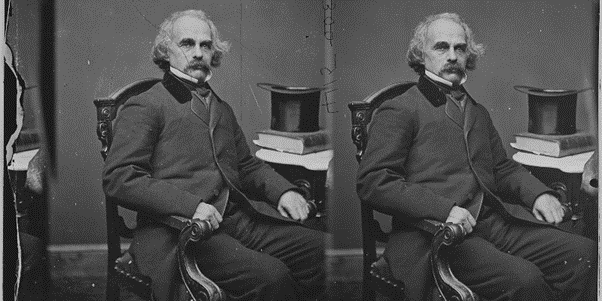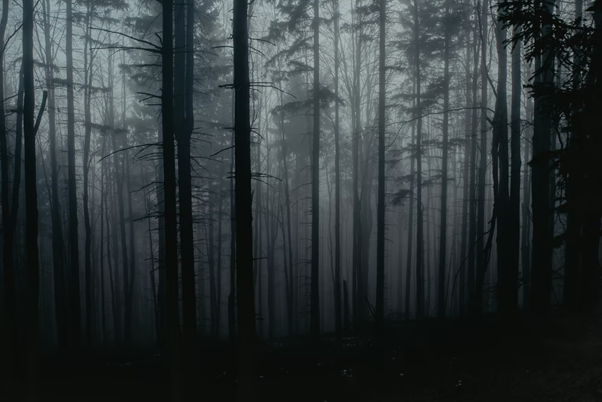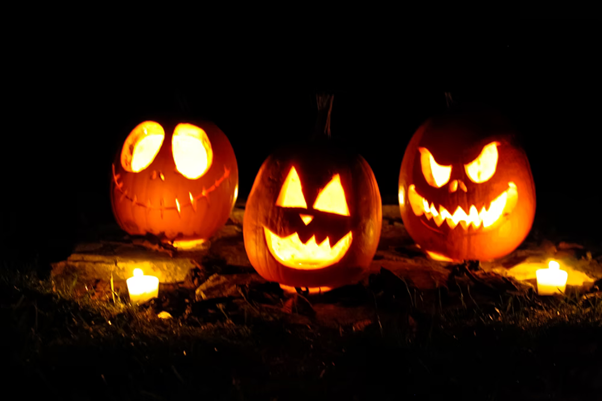What Makes a Story Scary?
With Halloween and the spooky season coming up, Young Goodman Brown (YGB) by Nathaniel Hawthorne was one of the first few stories to come to my mind. I remember feeling rather uneasy upon finishing it, pondering over a myriad of unanswered questions. Whether it was the haunting images or the inconclusive ending, something about the story left a strange feeling in me. Hawthorne is a master of drawing up enigmatic images, while leaving them ambiguous enough for the reader to fill in any (narrative) gaps.

Image of Nathaniel Hawthorne
Exploring the eerie elements of YGB
To me, the first thing that makes YGB eerie was the suspenseful build up. The first half of the story conjures a sense of uncertainty and fear as the readers simply do not know what to expect when Brown (the main character) embarks on an unexplained “journey.” He claims that “this one night must [he] tarry away,” without clarifying much purpose or motivation. Soon after, the third-person narrative itself paints the scene as ominous, underscoring the possibly evil intentions of this late trip. The readers start to question and doubt Brown as the story is permeated in darkness, through images such as “dark clouds,” the “dark wilderness,” and the “dark wall of a forest.”
Emanating uneasiness and doubt, this portion of the story remains mysterious and builds suspense. This build-up reaches a certain pitch of intensity when Brown “encounters” many more evil figures such as the devil, and when he witnesses himself the fall of pure characters. This intensity manifests through his cries, “My Faith is gone!” and “here comes goodman Brown. You may fear him as he fear you!” As he yells, he portrays a sense of hopelessness due to losing his loved ones (including his wife, fittingly named Faith), as well as his faith which he had built on others.
The ending, however, leaves readers with unexpected ambiguity. Though events play out extremely vividly and we see Goodman Brown’s (version of a) conclusion, questions are left unanswered and readers are left in the dark: Did the events truly happen to Brown? Or at least, did Brown really experience this, even if it was in his head?
The story hence incites active readership; the story of YGB extends towards its readers as we fill in the narrative gaps ourselves. Here, Hawthorne generalises the power of perspective — in the very construction of our interpretations, we are reminded of our own vested interests, biases, and blindspots, much like that of Goodman Brown’s. Brown’s struggles with perception extend to the everyman, not sparing the reader as we read the words and manufacture our own versions of the story and its ending.
This idea is presented in the emblematic line “Be it so, if you will,” acknowledging the fictitious nature of the story and thriving on its ambiguity. The words on the page draw on the notion that reality is constructed as we see it, subjective to the individual.

Sergiu Baica on Unsplash
Of course, the frightening mood also arises from the supernatural aspects of the text. Apart from the mystical setting and ghost-like images and figures, this paranormal mood is incited mainly by the blurred lines between reality and fiction. This operates on two layers: The reality in the story (main character’s worldview) against his imagination, as well as the true reality of the readers’ world and the fictional world of YGB.
What ties this together is the inclusion of historical names such as “Cloyse” and “Cory” — real people associated with witchcraft in the 1600s! Although these fictional works are framed as imagined and unreal, the remnants of the real world (that we know of) peppered through the text led me to feel slight uneasiness. Of course, including historical elements in a story does not immediately render a story more eerie. But when the fiction explores these paranormal themes on their own, the historical names, which conjure images of people who truly once lived, definitely adds to the layer of eeriness.
Lastly, perhaps it was scary simply because it touches on the struggle between values and perceptions — what we wish to see because of our faith and what we believe in. In Brown’s flirtation with ideas that oppose his outer persona (one built on goodness), the story unravels (and perhaps makes fun of) the dangers and surfaced guilt walking on these forbidden roads. At the same time, the story underscores his beliefs, which have been established as inheritance-based, and dependence on others, casting doubt on his fronted purity.
The confrontation with (or investigation of) what ‘true goodness’ is crystallises the pervading sense of discomfort. When even supposedly honest and good figures are associated with wrongdoing, the reader (as with Brown) is left with questions about purity and its possibilities. The conflation between desired goodness and vice could leave the reader uneasy and self-conscious.

Taylor Foss on Unsplash
Story for the spooky season
Personally, I have never been a really huge fan of horror stories. I often actively avoid scary films (where even cheap jump-scares or the crescendo of scary music could give me a huge fright) or spine-chilling posts since they leave me feeling extremely paranoid. Yet, YGB has a rather different approach to the lingering discomfort of typical spookiness we are familiar with — it does leave me pondering, but rather than leaving afterimages of ghosts or monsters, the persisting remnants instead involve questions like what it means to construct a story in our heads and what being moral entails. Perhaps then (from the perspective of a horror noob) fear and horror transcends simply frightening or shocking images.
At less than fifty pages, YGB is a quick yet impressionable read. I highly recommend reading it to examine themes of guilt and ‘true goodness,’ or simply to get yourself in the mood for Halloween in less than half an hour.
By: Shannon Ling
Director of ReadNUS Editorial Team
